I have a technique that will simplify the process of cleaning your cast iron wood stove. You can forget about the hassle of scrubbing and scraping because I will provide all the necessary guidance and suggestions to help your stove appear as good as new.
From prepping the stove to removing ash and debris, I’ll guide you through each step with ease.
So grab your cleaning supplies and let’s dive into the world of cast iron wood stove maintenance!
Key Takeaways
- Remove stubborn stains with warm water and mild dish soap
- Gather necessary tools and materials such as a wire brush, bucket, gentle dish soap, gloves, and safety goggles
- Remove ash and debris from the stove using a heat-resistant ash bucket, small brush or broom, and a vacuum cleaner with a HEPA filter
- Deep clean the cast iron surface using a soft cloth or sponge, mild dish soap, water, and a non-abrasive scrub brush
Preparing Your Cast Iron Wood Stove for Cleaning
I need to make sure my cast iron wood stove is properly prepared before I can begin cleaning it. There are a few pre-cleaning steps that are essential to ensure a thorough and effective cleaning process.

The first step is to remove any stubborn stains that may have accumulated on the surface of the stove. To do this, I use a mixture of warm water and mild dish soap. I dip a soft cloth into the soapy water and gently scrub the stained areas. For particularly tough stains, I may need to use a small scrub brush, being careful not to scratch the surface of the cast iron. Once the stains are removed, I rinse the stove thoroughly with clean water to remove any soap residue.
In addition to removing stains, it’s important to check for any loose or damaged parts on the stove. I inspect the door gasket, hinges, and handles to ensure they’re in good condition. If there are any issues, I make note of them and plan to address them after the cleaning process.
Gathering the Necessary Tools and Materials
To start, I’ll need a wire brush, a bucket, and some gentle dish soap. These cleaning supplies are essential for effectively cleaning a cast iron wood stove. Before I begin, it’s important to gather all the necessary tools and materials to ensure a thorough cleaning process.
Here’s a table to guide you on the cleaning supplies and protective gear you’ll need:

| Cleaning Supplies | Protective Gear |
|---|---|
| Wire brush | Gloves |
| Bucket | Safety goggles |
| Gentle dish soap | Apron |
Now that we have everything we need, let’s discuss their importance. A wire brush is essential for removing any debris or build-up on the surface of the stove. It helps in loosening the stubborn dirt and soot, making it easier to clean. A bucket will be useful for holding water and any cleaning solution you decide to use. As for the gentle dish soap, it is crucial for effectively removing grease and grime without damaging the cast iron surface.
In terms of protective gear, wearing gloves will protect your hands from any harsh chemicals or hot surfaces. Safety goggles are important to shield your eyes from any debris or cleaning solutions that may splash. Lastly, an apron will help protect your clothing from any potential stains or mess during the cleaning process.
Now that we have all our tools and protective gear ready, we can move on to the actual cleaning process.
Removing Ash and Debris From the Stove
Removing the ash and debris from the stove is an important step in maintaining its cleanliness and efficiency. Here are four easy steps to help you effectively remove the ash and debris from your cast iron wood stove:
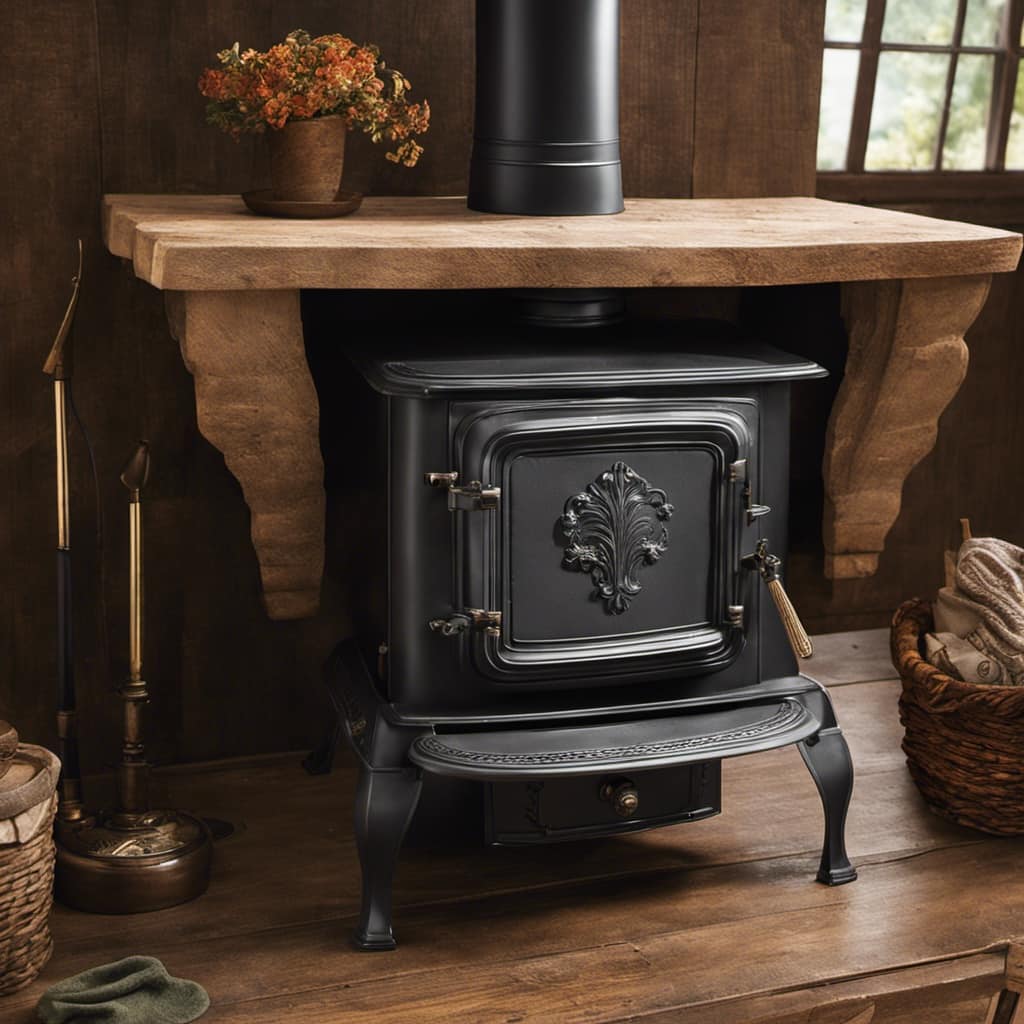
Prepare your tools: Before starting, gather a heat-resistant ash bucket, a small brush or broom, and a vacuum cleaner with a HEPA filter. These tools will make the cleaning process much easier and efficient.
Let the stove cool down: Make sure the stove is completely cool before attempting to remove the ash and debris. This will prevent any accidental burns or injuries.
Sweep the debris: Using a small brush or broom, gently sweep the loose debris and ash into a pile in the center of the stove. Be cautious not to scratch or damage the stove’s surface.
Vacuum the ash: Carefully use a vacuum cleaner with a HEPA filter to remove the remaining ash and debris. Use the crevice tool attachment to reach into corners and tight spaces. Be thorough in your vacuuming to ensure all the ash is removed.

By following these steps, you can effectively remove the ash and debris from your cast iron wood stove, ensuring its cleanliness and efficiency.
Once you’ve completed this step, you can move on to deep cleaning the cast iron surface.
Deep Cleaning the Cast Iron Surface
After removing the ash and debris, I found that deep cleaning the surface of my stove restored its shine and eliminated any lingering odors. Cast iron stoves can accumulate stubborn stains over time, but with the right cleaning techniques, you can bring back their original luster.
To restore the shine and remove any stubborn stains, follow these steps:

Gather your materials: You’ll need a soft cloth or sponge, mild dish soap, water, and a non-abrasive scrub brush.
Create a cleaning solution: Mix warm water with a small amount of mild dish soap in a bucket or sink.
Dip the cloth or sponge into the solution and gently scrub the surface of the stove. Pay extra attention to areas with stubborn stains. Avoid using abrasive cleaners or scrub brushes as they can damage the surface.
For tough stains, make a paste using baking soda and water. Apply the paste to the stained area and let it sit for a few minutes. Then, scrub gently with the non-abrasive brush.

Maintaining and Preventing Rust on Your Wood Stove
Maintaining the shine and preventing rust on my stove is important, so I always make sure to dry the surface thoroughly after cleaning.
In order to keep my wood stove in top condition, I follow these four steps:
Season the cast iron: Before using the stove for the first time, it’s crucial to season the cast iron. This creates a protective layer that helps prevent rust. Simply apply a thin coat of vegetable oil to the entire surface and bake it in the oven at a low temperature for about an hour. Repeat this process every few months to maintain the seasoning.
Clean and dry after each use: After each use, I clean the stove using a stiff brush or scraper to remove any ash or debris. Then, I wipe it down with a damp cloth and dry it thoroughly to prevent moisture from causing rust.

Use a rust inhibitor spray: To provide extra protection against rust, I occasionally spray a rust inhibitor specifically designed for cast iron surfaces. This helps to keep the stove rust-free and in good condition.
Store in a dry place: When the stove isn’t in use, I store it in a dry area. Moisture is the enemy of cast iron, so it’s important to keep it away from damp environments to prevent rust from forming.
Frequently Asked Questions
Can I Use Regular Household Cleaning Products to Clean My Cast Iron Wood Stove?
Yes, you can use regular household cleaning products to clean your cast iron wood stove. However, there are alternative cleaning methods that are specifically designed for this type of stove.
It’s important to note that using regular household cleaning products may have potential risks. These risks include damaging the cast iron or leaving behind residue that could affect the performance of the stove.
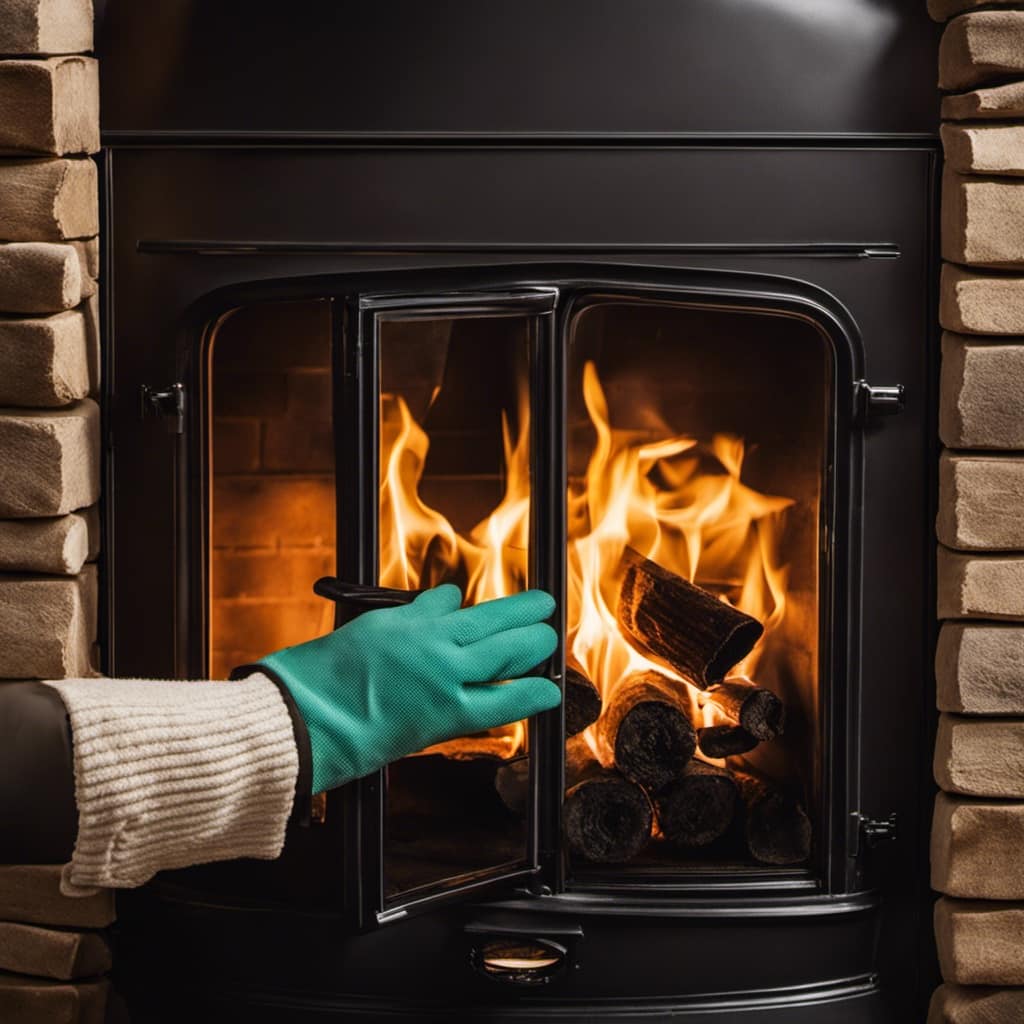
Therefore, it’s recommended to use specialized cleaners that are specifically formulated for cast iron wood stoves. These cleaners will ensure proper maintenance and longevity for your stove.
How Often Should I Clean My Cast Iron Wood Stove?
How often should I clean my cast iron wood stove?
It’s important to maintain regular cleaning to ensure optimum performance and longevity of your stove.
The frequency of cleaning depends on how frequently you use it. As a general rule, it’s recommended to clean your cast iron wood stove at least once a month during the heating season.
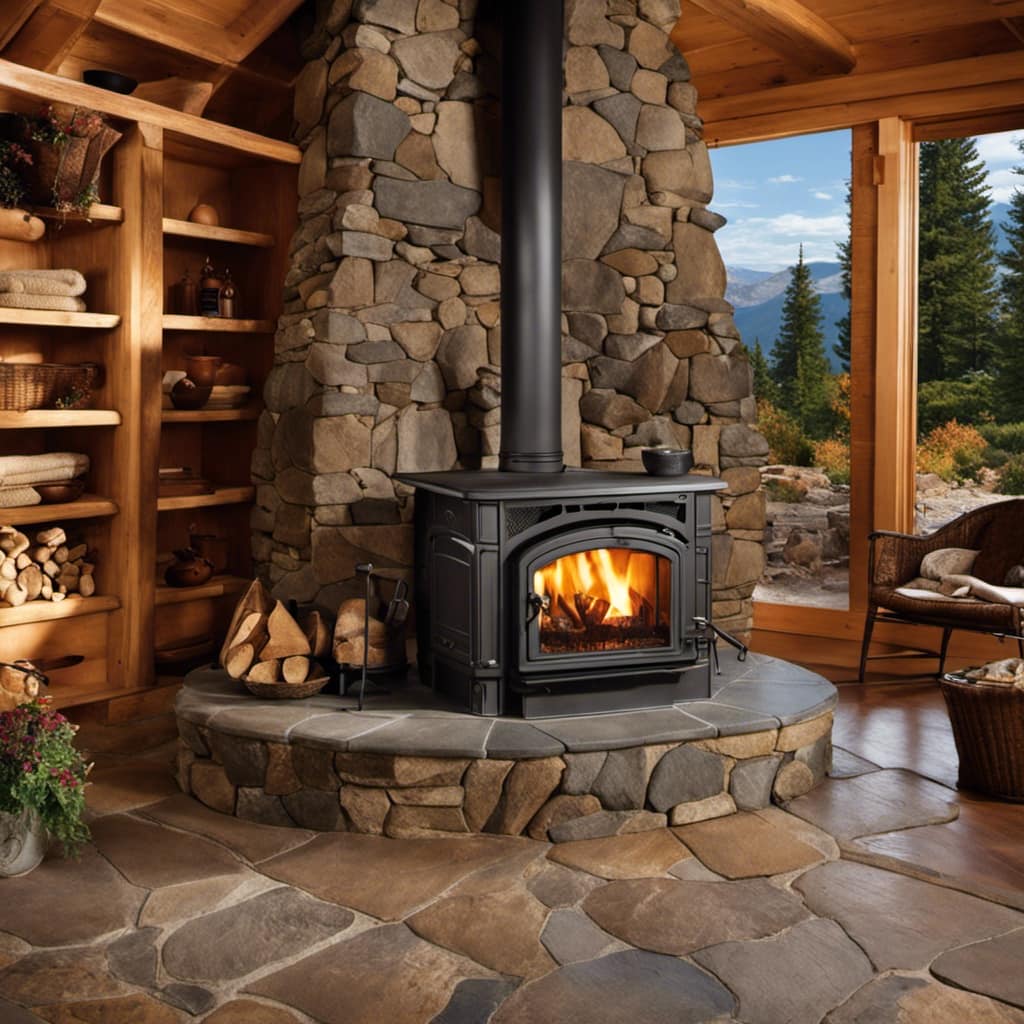
This will help prevent the buildup of soot, ash, and creosote, ensuring efficient and safe operation.
Let me now tell you the best cleaning methods for cast iron wood stoves.
Is It Safe to Use Abrasive Scrubbers or Steel Wool on the Cast Iron Surface?
Using abrasive scrubbers or steel wool on the cast iron surface of a wood stove isn’t recommended. These cleaning tools can scratch the surface and remove the seasoning that helps to prevent rust and preserve the cast iron.
Instead, opt for non-abrasive cleaning solutions and soft brushes or cloths to gently remove stains.
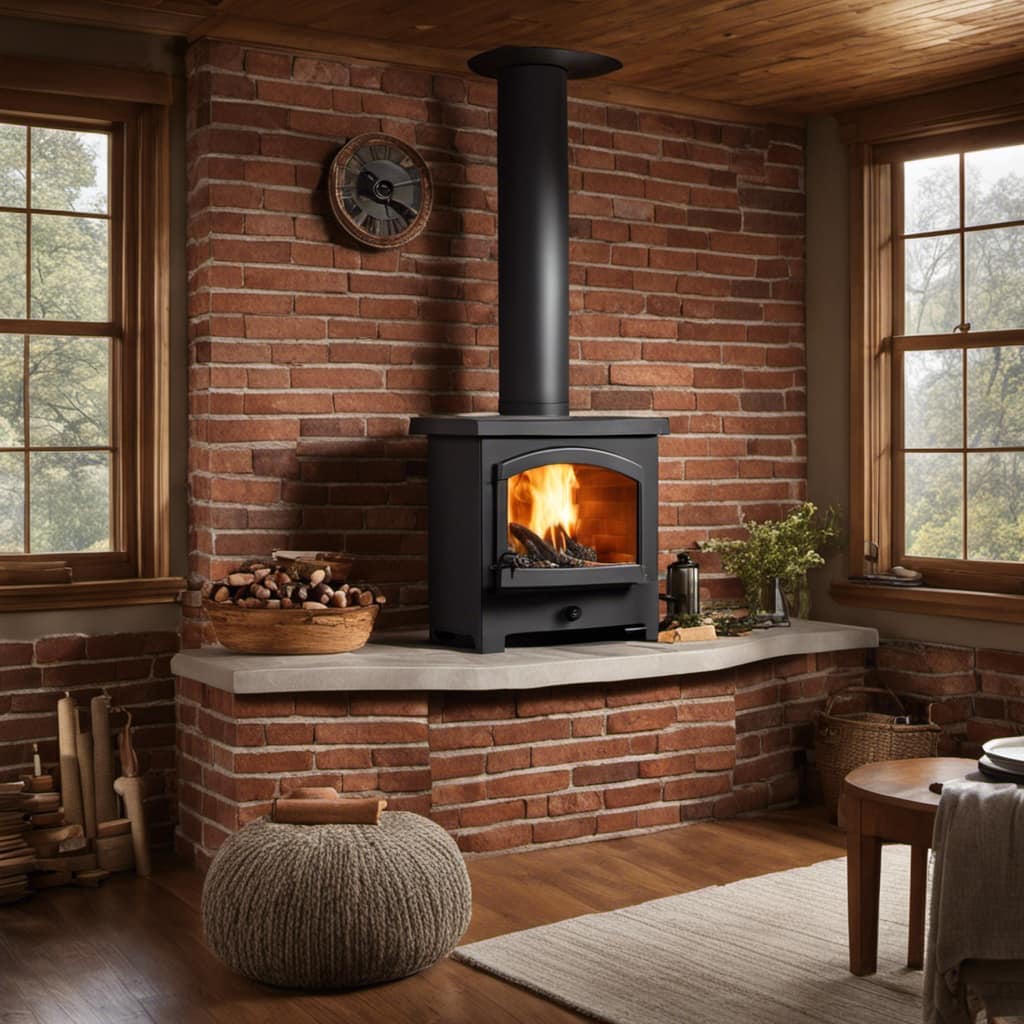
Regular maintenance and proper care are key to keeping your cast iron wood stove in great condition.
Can I Use Water to Clean the Inside of My Cast Iron Wood Stove?
Sure, I can answer that.
When it comes to cleaning the inside of a cast iron wood stove, using water is generally not recommended. Water can cause rusting and damage to the stove.
Instead, there are other cleaning methods specifically designed for cast iron wood stoves. These methods involve using a wire brush, ash vacuum, or dry cloth to remove any ash or debris.
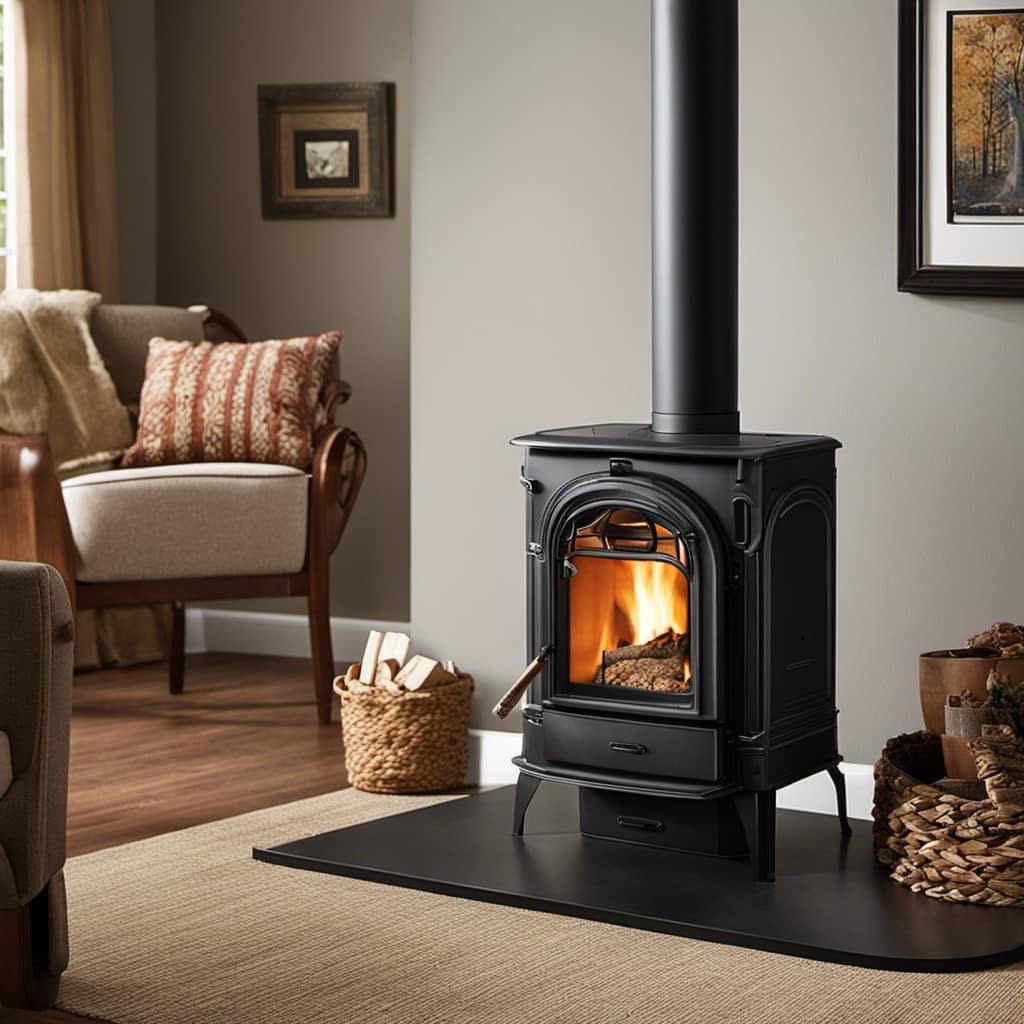
It’s important to avoid abrasive scrubbers or steel wool that can scratch the cast iron surface.
What Should I Do if There Are Stubborn Stains or Rust on My Cast Iron Wood Stove?
When dealing with stubborn stains or rust on a cast iron wood stove, it’s important to have effective rust removal methods and alternative cleaning solutions at hand.
I’ve had my fair share of experiences with this issue, and let me tell you, it can be quite challenging.
However, with the right techniques and products, you can restore your stove to its former glory.

Is the cleaning process different for a wood stove with a T in the back compared to a regular cast iron wood stove?
The cleaning process for a wood stove with a T in the back is slightly different from a regular cast iron wood stove. To clean the T in the back efficiently, it’s important to use a specialized brush to reach those tight spaces, while the regular cast iron stove may require a different cleaning approach.
Conclusion
In conclusion, by following these simple steps, you can easily clean and maintain your cast iron wood stove.
Remember, a well-maintained stove not only ensures efficient heating, but also adds a touch of rustic charm to your home.
So, grab your tools, roll up your sleeves, and let your wood stove shine like a diamond in the rough!
Growing up surrounded by the vast beauty of nature, Sierra was always drawn to the call of the wild. While others sought the comfort of the familiar, she ventured out, embracing the unpredictable and finding stories in the heartbeat of nature.
At the epicenter of every remarkable venture lies a dynamic team—a fusion of diverse talents, visions, and passions. The essence of Best Small Wood Stoves is crafted and refined by such a trio: Sierra, Logan, and Terra. Their collective expertise has transformed the platform into a leading authority on small wood stoves, radiating warmth and knowledge in equal measure.











